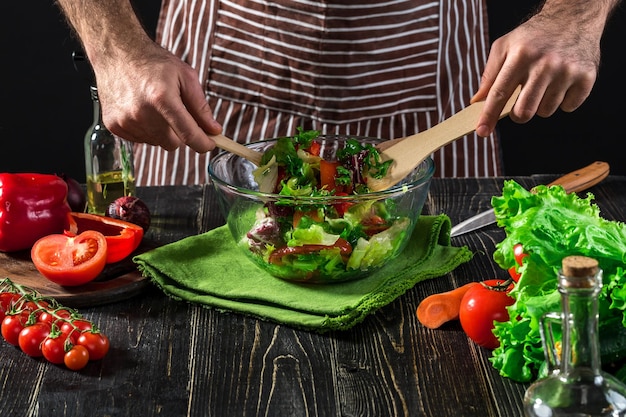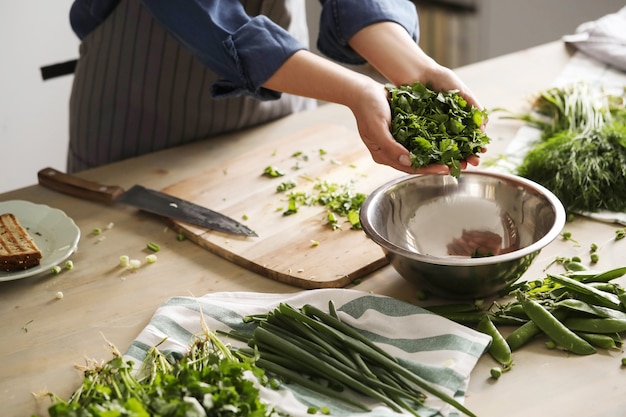I've always been a huge fan of greens. From the peppery bite of arugula to the buttery sweetness of spinach, there's a green for every taste and occasion. But, let's face it, cooking them can be tricky. Overcook them, and you're left with a sad, mushy mess. Undercook them, and they're tough and bitter.
That's why I've made it my mission to help you master the art of cooking greens. I've spent countless hours in the kitchen, experimenting and timing the perfect cooking times for all your favourite greens. Get ready to ditch the guesswork and embrace the delicious world of perfectly cooked greens, every time!
(Part 1) The Art of Cooking Greens: A Brief Overview

Before we dive into the nitty-gritty of cooking times, let's talk about the different methods you can use. Each technique has its own unique advantages and affects the texture and flavour of your greens.
1.1 Boiling: The Classic Method
Boiling is a tried-and-true method for cooking greens. It's quick, easy, and familiar. Simply submerge your greens in a pot of boiling water and let them cook until tender.
However, the downside of boiling is that it can lead to overcooked greens, which can become mushy and lose their vibrant colour. So, it's crucial to keep a watchful eye on the pot and remove the greens as soon as they're tender.
1.2 Steaming: Gentle and Delicious
Steaming is a gentler approach to cooking greens, and it's my personal favourite. It's a fantastic way to preserve the vibrant colour and nutrients of your greens while still achieving a tender texture.
The steam gently cooks the greens, preventing them from wilting too much and maintaining their delicate flavour. It's ideal for leafy greens like kale and spinach, as it keeps them from becoming soggy.
1.3 Sautéing: Quick and Flavorful
Sautéing is a great way to add a burst of flavour to your greens. Simply heat some oil or butter in a pan, toss in your greens, and cook them over medium heat until they're slightly wilted.
This method is perfect for quick side dishes or adding a bit of green goodness to your salads. You can even add garlic and onions for an extra flavour boost!
1.4 Stir-Frying: Fast and Exciting
Stir-frying is a high-heat cooking method that's perfect for quickly cooking greens. It's a great way to create dishes that are both flavourful and colourful.
The key to stir-frying is using a hot pan and constantly stirring the greens to prevent them from sticking or burning. It's a great option for adding greens to Asian-inspired dishes or creating quick and healthy meals.
(Part 2) The Perfect Cooking Times for Common Greens

Now, let's get down to the nitty-gritty! Here's a detailed guide to cooking times for some of the most popular greens, including boiling and steaming times. I've also included tips and tricks to help you achieve the best results.
2.1 Spinach: A Versatile Favourite
Spinach is a true kitchen hero. Its mild flavour makes it incredibly versatile, and it's a nutritional powerhouse. You can add it to salads, soups, stews, pasta dishes, and so much more.
2.1.1 Boiling Spinach
Bring a large pot of water to a rolling boil. Add spinach in batches, making sure not to overcrowd the pot. Let it cook for 2-3 minutes, or until wilted. Immediately drain the spinach and shock it in a bowl of ice water to stop the cooking process and preserve its vibrant green colour.
2.1.2 Steaming Spinach
Place spinach in a steamer basket over boiling water. Steam for 2-3 minutes, or until wilted. Remove the spinach from the steamer and serve immediately.
2.2 Kale: The Superfood Star
Kale, with its slightly bitter flavour and impressive health benefits, has become a modern kitchen staple. Its tough leaves need a bit more cooking time to achieve that perfect tender texture.
2.2.1 Boiling Kale
Remove the tough stems from kale leaves before cooking. Bring a large pot of water to a rolling boil. Add kale in batches, making sure not to overcrowd the pot. Cook for 5-7 minutes, or until tender. Drain the kale and shock it in a bowl of ice water.
2.2.2 Steaming Kale
Remove the tough stems from kale leaves. Place kale in a steamer basket over boiling water. Steam for 5-7 minutes, or until tender. Remove the kale from the steamer and serve immediately.
2.3 Chard: A Sweet and Savory Delight
Chard, with its vibrant stems and sweet flavour, is a delightful addition to any meal. Its sturdy leaves hold up well to various cooking methods.
2.3.1 Boiling Chard
Remove the tough stems from chard leaves. Bring a large pot of water to a rolling boil. Add chard in batches, making sure not to overcrowd the pot. Cook for 5-7 minutes, or until tender. Drain the chard and shock it in a bowl of ice water.
2.3.2 Steaming Chard
Remove the tough stems from chard leaves. Place chard in a steamer basket over boiling water. Steam for 5-7 minutes, or until tender. Remove the chard from the steamer and serve immediately.
2.4 collard greens: A Southern Staple
Collard greens, with their rich, earthy flavour and hearty texture, are a beloved Southern staple. Their thick leaves require a bit more cooking time to achieve that tender, melt-in-your-mouth feel.
2.4.1 Boiling Collard Greens
Remove the tough stems from collard green leaves. Bring a large pot of water to a rolling boil. Add collard greens in batches, making sure not to overcrowd the pot. Cook for 15-20 minutes, or until tender. Drain the collard greens and serve immediately.
2.4.2 Steaming Collard Greens
Remove the tough stems from collard green leaves. Place collard greens in a steamer basket over boiling water. Steam for 15-20 minutes, or until tender. Remove the collard greens from the steamer and serve immediately.
2.5 mustard greens: A Spicy Kick
Mustard greens, with their peppery flavour and bright green colour, add a spicy kick to any dish. Their delicate leaves cook quickly, so keep a close eye on them!
2.5.1 Boiling Mustard Greens
Bring a large pot of water to a rolling boil. Add mustard greens in batches, making sure not to overcrowd the pot. Cook for 3-5 minutes, or until wilted. Drain the mustard greens and serve immediately.
2.5.2 Steaming Mustard Greens
Place mustard greens in a steamer basket over boiling water. Steam for 3-5 minutes, or until wilted. Remove the mustard greens from the steamer and serve immediately.
2.6 Arugula: A Peppery Delight
Arugula, with its peppery bite and delicate texture, is a popular addition to salads and pizzas. Its delicate leaves cook quickly, so it's best to use it raw or lightly wilt it.
2.6.1 Sautéing Arugula
Heat a pan over medium heat. Add a little oil or butter. Add arugula and sauté for 1-2 minutes, or until wilted. Serve immediately.
2.7 Swiss Chard: A Versatile Green
Swiss chard is a versatile green with a mild flavour and slightly sweet taste. It’s a great source of vitamins and minerals, making it a healthy addition to any meal.
2.7.1 Boiling Swiss Chard
Remove the tough stems from swiss chard leaves. Bring a large pot of water to a rolling boil. Add swiss chard in batches, making sure not to overcrowd the pot. Cook for 5-7 minutes, or until tender. Drain the swiss chard and shock it in a bowl of ice water.
2.7.2 Steaming Swiss Chard
Remove the tough stems from swiss chard leaves. Place swiss chard in a steamer basket over boiling water. Steam for 5-7 minutes, or until tender. Remove the swiss chard from the steamer and serve immediately.
(Part 3) Cooking Greens for Different Dishes

Now that we've covered the basics of cooking greens, let's talk about how to prepare them for different dishes. Each recipe requires a slightly different approach to achieve the perfect texture and flavour.
3.1 Greens for Salads
Greens in salads are all about freshness and texture. A light wilt or a quick sauté is all they need.
3.1.1 Wilted Greens in Salads
For a simple wilted green salad, toss your greens with a light dressing and let them sit for a few minutes. The heat from the dressing will wilt the greens slightly, giving them a softer texture.
3.1.2 Sautéed Greens in Salads
To add a bit of flavour and texture to your salad, sauté your greens in a pan with a bit of oil or butter. Cook them for 1-2 minutes, or until wilted. Let them cool before adding them to your salad.
3.2 Greens for Soups and Stews
Greens in soups and stews are a wonderful way to add flavour and texture. They should be cooked until tender, but not mushy.
3.2.1 Adding Greens to Soup
Add your greens to the soup towards the end of cooking, so they don't overcook and become mushy. Let them simmer for a few minutes, or until tender.
3.2.2 Adding Greens to Stew
Add your greens to the stew towards the end of cooking, so they don't overcook and become mushy. Let them simmer for a few minutes, or until tender.
3.3 Greens for Stir-Fries
Greens in stir-fries need to be cooked quickly over high heat to retain their vibrant colour and crisp texture.
3.3.1 Stir-Frying Greens
Heat a pan over high heat. Add a bit of oil. Add your greens and stir-fry for 1-2 minutes, or until wilted. Serve immediately.
(Part 4) Tips for Cooking Greens Like a Pro
Now, let's delve into some tips and tricks that will take your green cooking skills to the next level.
4.1 Don't Overcrowd the Pot
When boiling or steaming greens, it's important not to overcrowd the pot. This will prevent the greens from cooking evenly and could lead to a mushy texture. Instead, cook them in batches to ensure they cook evenly and retain their vibrant colour.
4.2 Use Cold Water to Stop the Cooking Process
Once your greens are cooked, immediately shock them in a bowl of ice water to stop the cooking process and retain their bright green colour. This will prevent them from overcooking and becoming mushy.
4.3 Seasoning is Key
Don't forget to season your greens! A little salt, pepper, and a squeeze of lemon juice can transform a simple green side dish into something truly delicious. You can also experiment with other herbs and spices like garlic powder, onion powder, or red pepper flakes.
4.4 Consider Adding Garlic and Onion
Sautéing garlic and onion with your greens adds a burst of flavour. They're a great complement to any green and can enhance both their taste and aroma.
4.5 Don't Be Afraid to Experiment
Don't be afraid to experiment with different greens and cooking methods. The world of greens is vast and full of flavour. Try different combinations and find your own favourites.
(Part 5) Storage and Shelf Life
Properly storing your greens is crucial to keeping them fresh and delicious. Here's how to keep them at their best:
5.1 Storing Greens
Store greens in the refrigerator in a plastic bag or container, lined with a paper towel to absorb excess moisture. This will help keep them crisp and prevent them from wilting.
5.2 Shelf Life of Greens
Most greens will last for 3-5 days in the refrigerator if stored properly. However, it's always best to use them as soon as possible to ensure the best flavour and texture.
(Part 6) Cooking Greens for Different Diets
Greens are incredibly versatile and can be easily adapted to suit various dietary needs. Here's how to enjoy them on different diets:
6.1 Vegan and Vegetarian Cooking
Greens are naturally vegan and vegetarian-friendly. Simply cook them according to your preferred methods and enjoy them in your favourite dishes.
6.2 Gluten-Free Cooking
Greens are naturally gluten-free. Enjoy them in gluten-free dishes without any worries.
6.3 Low-Carb Cooking
Greens are low in carbohydrates and high in nutrients, making them a great choice for low-carb diets.
(Part 7) The Health Benefits of Eating Greens
Beyond their deliciousness, greens are nutritional powerhouses. They're packed with vitamins, minerals, and antioxidants that provide a wide range of health benefits.
7.1 Rich in Vitamins and Minerals
Greens are excellent sources of essential vitamins and minerals, including vitamin K, vitamin A, vitamin C, folate, and iron. These nutrients support overall health and well-being, from strong bones and healthy vision to energy production and cell growth.
7.2 High in Antioxidants
Greens are rich in antioxidants, which help protect your cells from damage caused by free radicals. This can reduce the risk of chronic diseases like heart disease, cancer, and Alzheimer's disease.
7.3 Promotes Digestive Health
Greens are a good source of fiber, which is essential for a healthy digestive system. Fiber helps regulate bowel movements and keeps your gut bacteria happy, contributing to overall gut health.
7.4 Low in Calories
Greens are low in calories and high in volume, making them a great choice for weight management. They can help you feel full and satisfied without consuming excessive calories, contributing to a balanced diet.
(Part 8) FAQs
Let's answer some common questions about cooking greens.
8.1 Can you overcook greens?
Yes, you can definitely overcook greens. Overcooked greens become mushy and lose their flavour and nutrients. It's important to cook them until tender, but not mushy.
8.2 What are the best ways to cook greens?
There are many ways to cook greens, including boiling, steaming, sautéing, and stir-frying. The best method depends on your personal preference and the recipe you're making.
8.3 What are the healthiest ways to cook greens?
Steaming and sautéing are often considered the healthiest ways to cook greens because they retain more nutrients than boiling.
8.4 How do you know when greens are done?
Greens are done when they are tender but still have a slight bite. They should not be mushy.
8.5 What are some good recipes for greens?
There are endless possibilities when it comes to cooking greens. Here are a few ideas to get you started:
- Sautéed Greens with Garlic and Onion
- Spinach and Feta Salad
- Kale Chips
- Collard Green Soup
- Stir-Fried Mustard Greens
- Creamy Spinach and artichoke dip
- Spinach and Ricotta Quiche
- Kale and Sausage Pizza
- Green Smoothie
- Roasted Greens with Balsamic Glaze
These are just a few examples, and the possibilities are endless!
(Part 9) Conclusion
Cooking greens is a culinary adventure, and I hope this guide has armed you with the knowledge and confidence to master the art of green cooking. Embrace the vibrant colours, the earthy flavours, and the countless health benefits.
Remember, the key to perfectly cooked greens is understanding their unique characteristics and applying the right techniques. So, grab your favourite greens, put on your apron, and get ready to create delicious and healthy dishes that will nourish your body and soul.
Everyone is watching

Perfect Rice Every Time: The Ultimate Guide to Cooking Rice
Cooking TipsAs a self-proclaimed foodie, I've always been a bit obsessed with rice. It's the foundation of countless cuisi...

The Ultimate Guide to Cooking Asparagus: Tips, Techniques, and Recipes
Cooking TipsAsparagus. The mere mention of this spring delicacy conjures up images of vibrant green spears, crisp and burs...

Ultimate Guide to Cooking the Perfect Thanksgiving Turkey
Cooking TipsThanksgiving. Just the word conjures up images of overflowing tables laden with delicious food, the scent of r...

Prime Rib Roast Cooking Time Chart: Per Pound Guide
Cooking TipsPrime rib roast. Just the name conjures images of lavish dinners, crackling fires, and hearty laughter. It’s ...

Can You Cook Spaghetti with Gasoline? (The Shocking Truth)
Cooking TipsWe've all seen those crazy internet trends. You know, the ones that make you wonder, "Did someone actually try...
